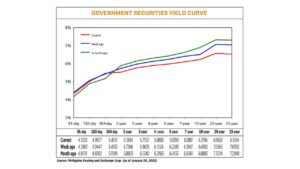




Policy Rate Updates: Double cut finale
 DOWNLOAD
DOWNLOAD

Monthly Economic Update: One for the road
 DOWNLOAD
DOWNLOAD

Inflation Update: Still low, still slow
 DOWNLOAD
DOWNLOAD


Yields on government debt decline on dovish Fed, BSP

 YIELDS on government securities (GS) declined last week as the market expects smaller rate increases from the US Federal Reserve and the Bangko Sentral ng Pilipinas.
YIELDS on government securities (GS) declined last week as the market expects smaller rate increases from the US Federal Reserve and the Bangko Sentral ng Pilipinas.
GS yields, which move opposite to prices, dropped by 23.44 basis points (bps) on average week on week, based on PHP Bloomberg Valuation Service Reference Rates as of Jan. 20 published on the Philippine Dealing System’s website.
Rates at the short end of the curve fell except for the 364-day Treasury bill (T-bills), which saw its yield inch up by 4.01 bps to 5.4531%. Meanwhile, the 91- and 182-day T-bills decreased by 7.67 bps and 4.7 bps to fetch 4.312% and 4.9977%, respectively.
At the belly of the curve, rates of the two-, three-, four-, five-, and seven-year Treasury bonds (T-bonds) decreased by 20.82 bps (to 5.5184%), 20.78 bps (5.7557%), 22.43 bps (5.8883%), 25.83 bps (5.97%), and 30.6 bps (6.0887%), respectively.
The long end of the curve likewise moved downwards as yields on the 10-, 20-, and 25-year debt papers fell by 27.96 bps (to 6.2196%), 49.15 bps (6.565%), and 51.96 bps (6.5154%), respectively.
Total GS volume traded amounted PHP 13.842 billion on Friday from the P30.902 billion recorded on Jan. 13.
A bond trader attributed the downward movement of GS rates last week to investors’ preference for higher-yielding longer tenors amid expectations of slower tightening by the Fed and the BSP.
“More on improved risk sentiment as drop in US Treasury yields and weak US data are causing traders to price in a rate cuts this year, thus lessening pressure on emerging markets like the Philippines to match Fed rate hikes,” the bond trader said in a Viber message last week.
“Short-term tenors corrected slightly lower week on week while long-term PHP BVAL (Bloomberg Valuation Service) yields continued to post the biggest declines for the second straight week after recent dovish signals or possible smaller rate hikes by the Fed and locally,” Rizal Commercial Banking Corp. Chief Economist Michael L. Ricafort said in a Viber message.
On Wednesday, Philadelphia Federal Reserve President Patrick Harker signaled a less hawkish stance, Reuters reported.
“I expect that we will raise rates a few more times this year, though, to my mind, the days of us raising them 75 basis points at a time have surely passed,” Mr. Harker said about the heavy rate hiking cycle embraced by the Fed in the previous year.
Other US Fed policy makers are also expected to support for a higher and continuous interest rate hikes for the year to bring the fed funds rate to 5%-5.25% from 4.25-4.5% currently amid slowing inflation and weaker economic activity.
The US central bank increased borrowing costs by 425 bps last year.
Back home, BSP Governor Felipe M. Medalla this month said the central bank is likely to raise benchmark rates by 25 or 50 bps at its meeting on Feb. 16 as it still needs to anchor inflation expectations.
The BSP hiked rates by 350 bps in 2022 in an effort to bring down elevated prices, with its key rate now at 5.5%.
For this week, the bond trader said yields may continue to move downward “as long as US data continue to support the assumptions of a pause or cut in policy rates.”
Rates could also drop amid increased supply of T-bonds following the Treasury’s full awarding of its first two offerings for the month. — M.I.U. Catilogo
This article originally appeared on bworldonline.com





 By BusinessWorld
By BusinessWorld